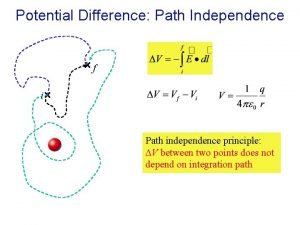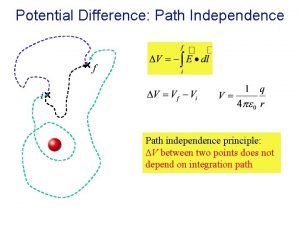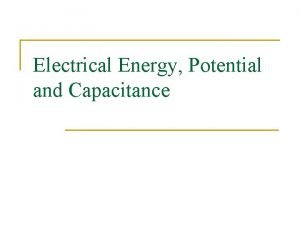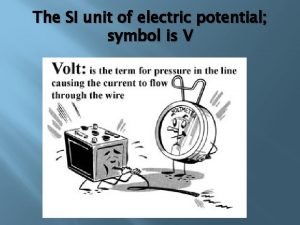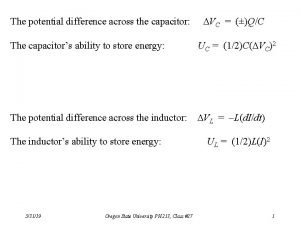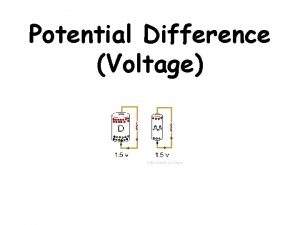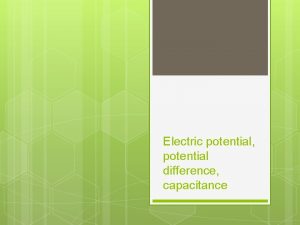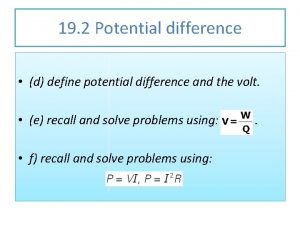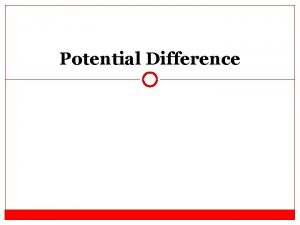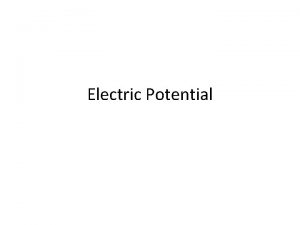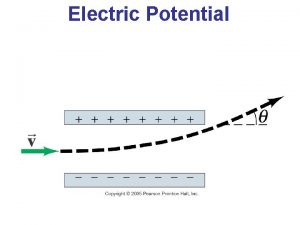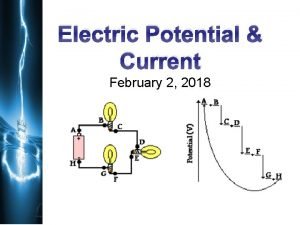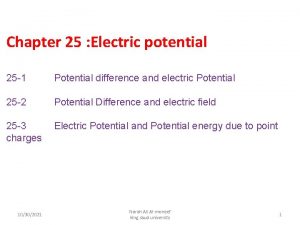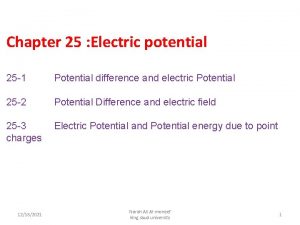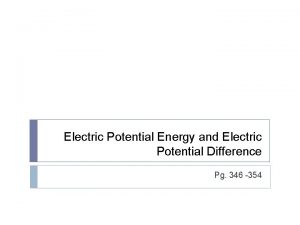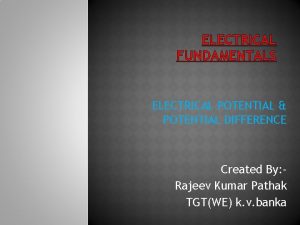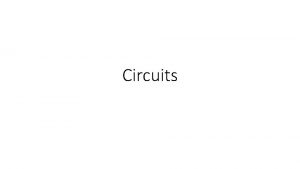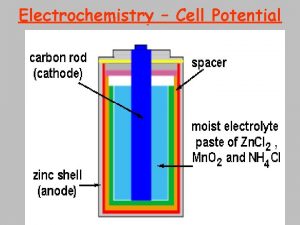Potential Difference Path Independence f i Path independence



























- Slides: 27

Potential Difference: Path Independence f i Path independence principle: V between two points does not depend on integration path

Potential Difference in Metal In static equilibrium What is E inside metal? E = 0 In static equilibrium the electric field is zero at all locations along any path through a metal. What is the potential difference (Vf – Vi)? f i The potential difference is zero between any two locations inside the metal, and the potential at any location must be the same as the potential at any other location. Is V zero everywhere inside a metal? No! But it is constant

Potential in Metal In static equilibrium A Capacitor with large plates and a small gap of 3 mm has a potential difference of 6 Volts -Q +Q from one plate to the other. E -3 V +3 V d =3 mm V = 6 Volt Charges are on surface

Potential in Metal In static equilibrium -Q 1 1 mm +Q 1 X d =3 mm V = 4 V Charges +Q 2 and –Q 2 Insert a 1 mm thick metal slab into the center of the capacitor. Metal slab polarizes and has charges +Q 2 and -Q 2 on its surfaces. What are the charges Q 1 and Q 2? At X E=0 inside metal Q 2=Q 1 Now we have 2 capacitors instead of one Ignoring the fringe fields, E = 2000 V/m in each capacitor (from previous slide). V inside metal slab is zero! There is no “conservation of potential”!

Potential in Metal There can be a potential in metal if is NOT in static equilibrium Metal is not in static equilibrium: • When it is in the process of being polarized • When there is an external source of mobile charges (battery) If a metal is not in static equilibrium, the potential isn’t constant in the metal. Nonzero electric field of uniform magnitude E throughout the interior of a wire of length L. Direction of the field follows the direction of the wire.

Question 300 V/m A B 0. 02 m What is VB-VA? 0. 03 m A) B) C) D) E) 270 V -18 V 6 V -6 V 0. 04 m

Question 0 V/m A B 0. 02 m 0. 04 m 0. 03 m x 0

Round Trip Potential Difference + Potential difference due to a stationary point charge is independent of the path Potential difference along a closed loop is zero

Predicting Possible Field Configuration Is the following “curly” pattern of electric field possible? dl dl is always parallel to dl This “curly” pattern of electric field is impossible to produce by arranging any number of stationary point charges!

Potential of a Uniformly Charged Ring Q Method 1: Divide into point charges and add up contributions due to each charge

Potential of a Uniformly Charged Ring Q Method 2: Integrate electric field along a path

Potential of a Uniformly Charged Ring Q What is V for z>>R ? The same as for a point charge!

Potential of a Uniformly Charged Disk one ring: integrate:

Potential of a Uniformly Charged Disk Can find :

Potential Difference in an Insulator Electric field in capacitor filled with insulator: Enet=Eplates+Edipoles Eplates=const (in capacitor) Edipoles, A Edipoles, B A B Edipoles complicated f(x, y, z) Travel from B to A: Edipoles is sometimes parallel to dl, and sometimes antiparallel to dl 1 2 3 4 5

Potential Difference in an Insulator Instead of traveling through inside – travel outside from B to A: Edipoles, average A B Enet=Eplates+Edipoles, average Enet< Eplates Effect of dielectric is to reduce the potential difference.

Dielectric Constant Electric field in capacitor filled with insulator: Enet=Eplates-Edipoles K – dielectric constant

Dielectric Constant Inside an insulator: Dielectric constant for various insulators: vacuum air typical plastic Na. Cl water strontium titanate 1 (by definition) 1. 0006 5 6. 1 80 310

Potential Difference in a Capacitor with Insulator s

Potential Difference in Partially Filled Capacitor d +Q -Q K A s B x

Energy Density of Electric Field Energy can be stored in electric fields (for small s) volume E Field energy density: (J/m 3) Energy expended by us was converted into energy stored in the electric field

Energy Density of Electric Field In the previous slide, the “system” is the set of two plates. Work, Wexternal > 0, is done on the system by you – part of the “surroundings. ” If the force exerted by you just offsets the attractive force, Fby-plates, so that the plate moves with no gain in KE,

Electric Field and Potential 90 V 100 V x Ex 1 mm

Exercise Suppose in some area of space V(x, y, z)=x 2+yz. What is E(x, y, z)?

Potential Inside a Uniformly Charged Hollow Sphere =0 In general, integration path may be complex

Electron-Volt (e. V) – Unit of Energy What is the change in electric potential energy associated with moving an electron from 1Å to 2Å from a proton? If an electron moves through a potential difference of 1 V there is a change in electric potential energy of 1 e. V = e. (1 V) = (1. 6. 10 -19 C)(1 V) = 1. 6 10 -19 J

Shifting the Zero Potential In most cases we are interested in V, not the absolute values of V
 Equipotential lines
Equipotential lines Electric potential and potential energy
Electric potential and potential energy Market potential and forecasting
Market potential and forecasting Electric potential and potential difference
Electric potential and potential difference Electric potential due to dipole
Electric potential due to dipole What is electric potential
What is electric potential Potential difference is path independent
Potential difference is path independent Potential difference
Potential difference Difference between potential difference and emf
Difference between potential difference and emf How to find pressure potential
How to find pressure potential Water potential in plants
Water potential in plants Calculating solute potential
Calculating solute potential Neuronal pool
Neuronal pool Graded potential vs action potential
Graded potential vs action potential Action potential
Action potential Graded potential vs action potential
Graded potential vs action potential Absolute refractory period
Absolute refractory period How to find pressure potential
How to find pressure potential Source of bioelectric potential is dash in nature
Source of bioelectric potential is dash in nature End-plate potential vs action potential
End-plate potential vs action potential Intubating dose succinylcholine
Intubating dose succinylcholine Axon hillock
Axon hillock Action potential resting potential
Action potential resting potential Electric potential energy definition
Electric potential energy definition V=pe/q
V=pe/q Unity signalr
Unity signalr Symbol for electric potential
Symbol for electric potential Potential difference across a capacitor
Potential difference across a capacitor






